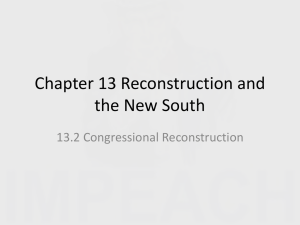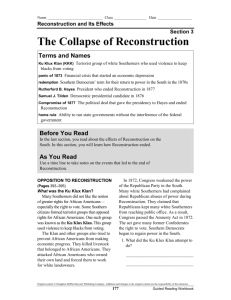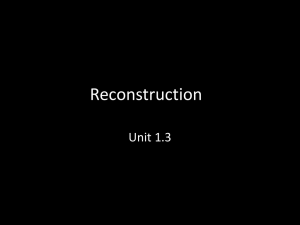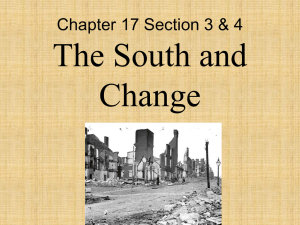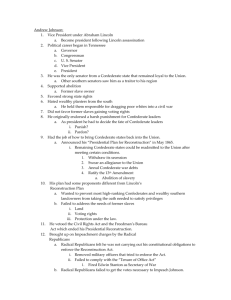Chapter 17 Reconstruction and the New South (1865
advertisement
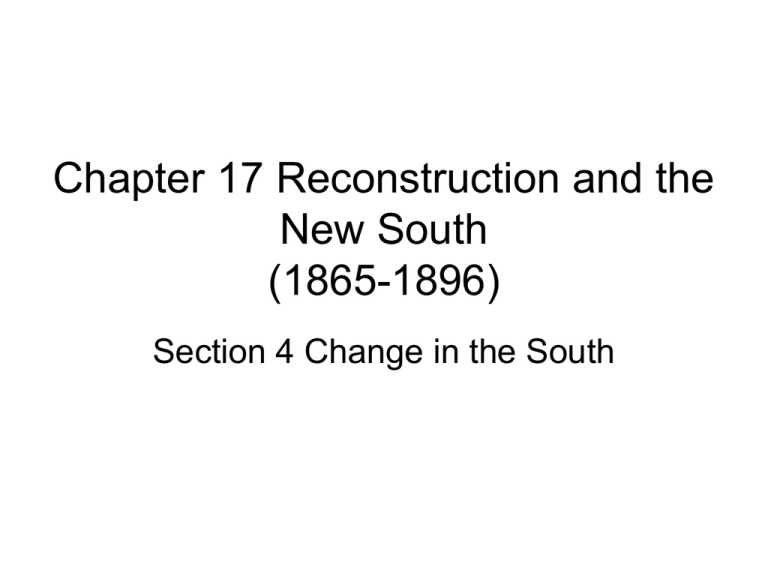
Chapter 17 Reconstruction and the New South (1865-1896) Section 4 Change in the South t i o n Which of the following is most important to gaining freedom and equality? A. Education B. Money C. The right to vote D. The right to run for government office 0% A A. A B. B C. 0% C0% D. D B C 0% D i o n How did the South change politically, economically, and socially when Reconstruction ended? Grant’s Administration • During Grant’ administration, Northerners began losing interest in Reconstruction • It was time for the South to solve its own problems • Radical leaders began to disappear from politics (Thaddeus Stevens died) • Southerners felt they knew how to deal with African Americans • Southerners protested what they called the “bayonet rule” • The use of federal troops to support Reconstruction governments Republican Revolt • 1870s- Rumors of corruption in Grant’s administration and in Reconstruction governments spread • Some Republicans split the party over the issue of corruption • Another broke away over Reconstruction • Called themselves the Liberal Republicans • Nominated Horace Greeley to run against Grant in 1872 • Grant was reelected Amnesty Act • Pardoned most former Confederates • Full rights were granted including voting • Most were in the Democratic party • Democrats soon gained control of state governments in the South • The KKK helped the Democrats take power by terrorizing Republican voters Republican Problems • 1873- A series of political scandals came to light • One scandal was with the vice president • These scandals damaged the Grant administration and the Republicans • Grant and the nation also endured a severe economic depression • Started with the Panic of 1873 when a series of bad railroad investments forced the powerful banking firm of Jay Cooke and Company to declare bankruptcy Panic of 1873 • Forced small banks to close and the stock market to plummet • 1000s of businesses shut down • Tens of 1000s of Americans were out of work • Blame for the hard times fell on the Republicans • Congressional election of 1874- Democrats gained seats in the Senate and House of Representatives • This weakened Congress’ commitment to Reconstruction • And on protecting African American Rights Election of 1876 • The Republicans wanted someone besides Grant • Republicans wanted to win back Liberal Republicans and unite the party • The Republicans nominated Rutherford B. Hayes, governor of Ohio • Hayes was honest and had moderate views of Reconstruction • Democrats nominated Samuel Tilden, governor of New York • Tilden gained fame by fighting corruption in New York City Election of 1876 Continued • Tilden looked like the winner (250,000 more votes) • 4 states had disputed results and kept the outcome in doubt • Tilden had 184 electoral votes. • 1 short of winning • Hayes needed all 20 of the disputed votes to win • A commission was set up to decide and they voted 8 to 7 to award all 20 votes to Hayes Compromise of 1877 • Democrats in Congress threatened to fight the decision • Republicans and Southern Democrats reportedly met in secret to work out an agreement • March 2, 1877- Hayes was declared the winner • The Compromise of 1877The new government would give more aid to the South • Republicans would withdraw all remaining troops from Southern states • The Democrats promised to maintain African American rights A New Policy • In his Inaugural Address, Hayes declared that what the South needed most was… • The restoration of “wise, honest, and peaceful local self-government” • Hayes decided to let the Southerners handle racial issues • The federal government would no longer attempt to reshape Southern society • Reconstruction was over Democrats in Control • Large landowning Democrats took power • But also merchants, bankers and other business leaders who supported economic development • They called themselves “Redeemers” • They redeemed the South from Republican rule • They adopted conservative policies (lower taxes and reduced government spending) • They cut services from Reconstruction (Including public education) • These policies dominated Southern politics into the 1900s Rise of the New South • Southerners looked to develop a strong industrial economy • This “New South” would have industries based on the region’s abundant coal, iron, tobacco, cotton, and lumber • Textile and iron mills sprang up across the South • Industry grew because there was a cheap and reliable workforce • Factory workers put in long hours for low wages • The railroad system was rebuilt and doubled in 10 years (1880 to 1890) • Agriculture remained the South’s main economic activity Rural Economy • Supporters of the New South wanted to have the small farms raise a variety of crops rather than cotton • But most went to unprofitable sharecropping • Debt caused problems for poor farmers • To repay debts, farmers grew cash crops • Main crop was cotton • Too much cotton was produced and prices fell • • • • • • • • A Divided Society Dreams of justice faded for African Americans when Reconstruction faded The 15th Amendment prohibited states from denying the right to vote because of race Southerners found a way to get around this Amendment Southerners required a poll tax (many African Americans and poor whites couldn’t vote) Another approach was to make prospective voters take a literacy test (Had to read difficult parts of the Constitution) Literacy tests also kept some whites from voting so some states passed grandfather clauses If your father or grandfather voted it gave you the right to vote These laws and threat of violence caused African American voting to decline drastically Jim Crow Laws • By 1890s segregation was a common feature of the South • The South passed Jim Crow laws that required African Americans and whites to be separated in almost every public place • 1896- Plessy v. Ferguson- Segregation was legal as long as it was equal • “Separate but equal” • The facilities were in no way equal • White violence rose including lynching Reconstruction’s Impact • Reconstruction was a success and a failure • It helped the South rebuild its economy • But most of the South remained agricultural and poor • African Americans gained greater equality, created their own institutions, and shared in governments with whites • Their advancements did not last • Civil rights leader W.E.B. Du Bois said “The slave went free, stood a brief moment in the sun; then moved back again toward slavery” i o n How did the South change politically, economically, and socially when Reconstruction ended? -Politically: power shifted to Democrats, who instituted conservative policies -Economically- developed more industries, agriculture included sharecropping and tenant farming as well as large plantations -Socially- laws created segregation and limited African American voting rights, white violence against African Americans increased Chapter 17 Section 4 Quiz • THE LAST ONE! Most former Confederates were pardoned by the A. Confederate Act. B. Amnesty Act. C. Fifteenth Amendment. D. Fourteenth Amendment. Fo ur te en th Am Fif t ee nt h Am Am en dm en t. en dm st y ne te ra Co nf ed e en t. Ac t. Ac t. 25% 25% 25% 25% Reconstruction ended with the A. Amnesty Act. B. Compromise of 1877. C. Civil Rights Act of 1875. D. Fifteenth Amendment. ee nt h Fif t ht s ig il R Ci v Am en dm en t. 18 75 . of Ac t ise m pr o Co m Am ne st y Ac t. of 18 77 . 25% 25% 25% 25% Farmers thought that the quickest way to repay debt was to grow n. 25% co r ps . cr o h ca s ca n 25% co . 25% e. 25% to ba c sugarcane. cash crops. tobacco. corn. su ga r A. B. C. D. . ol l ap n ct io st ru co n Re ta x s. w la la Cr ow Jim ac ro p ta w x. s. As a means of keeping poor people and African Americans from voting, many Southern states required A. a crop tax. 25% 25% 25% 25% B. Jim Crow laws. C. Reconstruction laws. D. a poll tax. What type of society did Southern states form by passing the Jim Crow laws? A. an integrated society B. a healthy society C. a segregated society D. an economic society om ec on an ga t eg re as ic ed ys oc lth ea ah so cie ty so c ie ty ie ty so cie d te gr a in te an ty 25% 25% 25% 25% Participant Scores 0 0 Participant 1 Participant 2 0 0 0 Participant 3 Participant 4 Participant 5 Team Scores 0 0 Team 1 Team 2 0 0 0 Team 3 Team 4 Team 5


